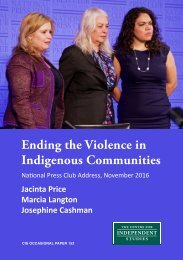Final Report Strong Fathers Strong Families Programme Descriptive Analysis
Final Report Strong Fathers Strong Families Programme Descriptive Analysis
Final Report Strong Fathers Strong Families Programme Descriptive Analysis
Create successful ePaper yourself
Turn your PDF publications into a flip-book with our unique Google optimized e-Paper software.
Recruitment of programme participants was challenging for many sites, but had become easier over timeas the programme became more established in the community. Stakeholders reported that some menwere reluctant to participate because they felt ashamed or lacked confidence, were not interested in thecontent of the course/programme, did not trust government-run programmes, or lacked money andtransport to access activities for which transport was not provided.To varying degrees, organisations had overcome challenges in recruiting participants through variousrecruitment strategies. Several organisations adopted a ‘phased’ approach to implementation whichinvolved encouraging men into the programme through activities that were fun and engaging such as gymsessions, men’s camps and cultural activities. Over time, as relationships and trust developed,organisations started tackling more difficult and sensitive issues such as substance use and familyviolence. Another recruitment strategy involved promoting the programme to women who could thenpromote the programme to their husbands and partners.Many SFSF organisations were working in partnership with other community organisations to promote theprogramme and recruit participants. As an example, one organisation was delivering the programme toresidents in a residential drug and alcohol facility. Another organisation was recruiting men that weresubject to a Work and Development Order issued by the NSW State Debt Recovery Office. Under thisarrangement, men participated in SFSF activities and events in order to reduce outstanding debt.Partnerships assisted with recruitment, but also allowed SFSF organisations to provide more holistic careto programme participants and address the range of problems they were facing.STAFF RECRUITMENT AND WORKFORCE IMPLICATIONSRecruitment of Aboriginal and Torres Strait Islander workers for the SFSF programme has been difficultfor some organisations but not all. Several organisations reported that encouraging applications fromAboriginal and Torres Strait Islander men was challenging but encouraging applications fromappropriately qualified men was even more challenging. There were a range of reasons cited for thisincluding a relatively low salary for the SFSF Coordinator role, a transient workforce and a lack of interestin the position. According to one stakeholder, recruitment was further complicated by the requirement toemploy Aboriginal and Torres Strait Islander men, who were perceived as harder to recruit thanAboriginal and Torres Strait Islander women in some communities.A key concern was defining the role of the SFSF Coordinator. In some locations, the SFSF Coordinatorhad become a ‘go to’ person in the community and provided a case management service for programmeparticipants. Although this one-on-one support was seen as an essential component of the SFSFprogramme, there was concern that SFSF Coordinators did not have the capacity to case managemultiple men and follow-up referrals.OUTCOMESDespite some challenges in recruiting participants, stakeholders reported that when men did participate inthe programme, they generally responded well to it. Attendance fluctuated and could be unpredictable butin most sites the number of participants was growing. According to stakeholders, participation in theprogramme delivered a number of positive outcomes for men, including:• increased self-esteem• improved health outcomes and health literacy• improved access to services• education, training and employment opportunities• increased connection to community and willingness to share issues and concerns• increased connection to culture.ii EXECUTIVE SUMMARYURBISFINAL REPORT



